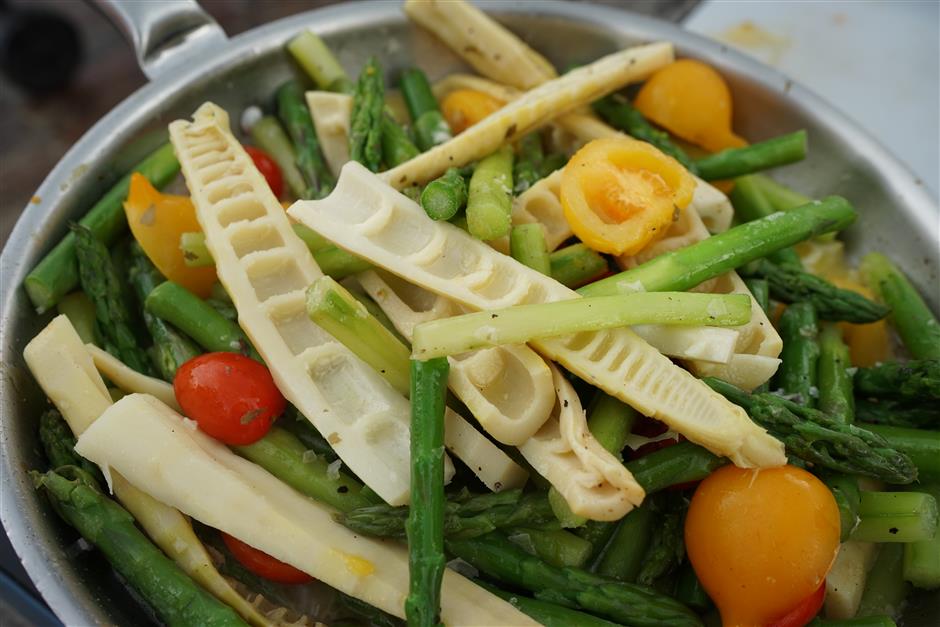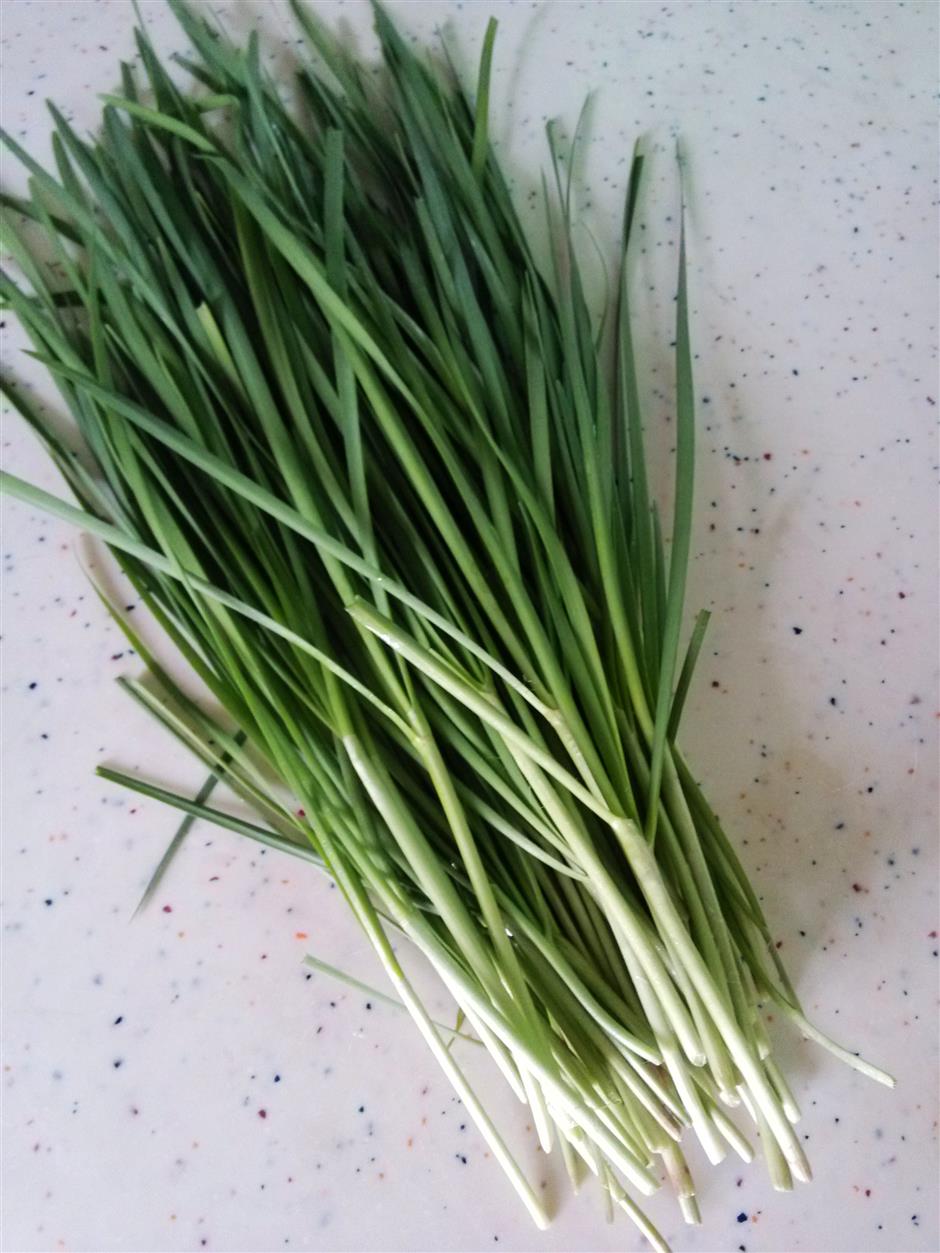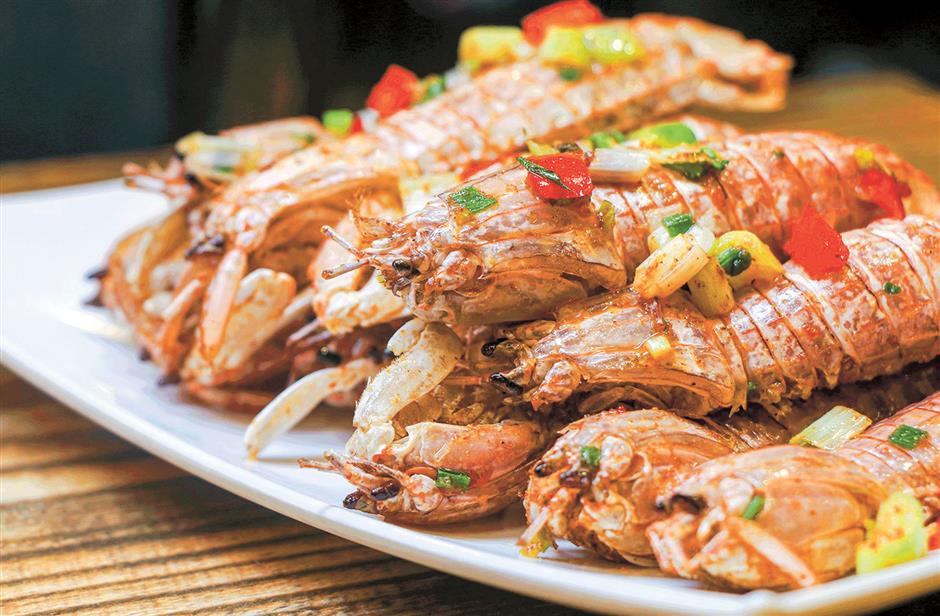Taste finger-licking good foods now at their best
Chinese cuisine emphasizes on making the best use of seasonal ingredients, and the fresh produce and catches of spring are sure remedies to help the body make the transition from the bold and rich flavors of the cold winter days.
This week, we select four ingredients worth trying in spring, including two vegetables, fish and shrimp.
Spring bamboo shoot
The spring bamboo shoot harvested before the Qingming Festival, which falls on April 5 this year, is a delicacy not to be missed in Shanghai and which is also easy to find at a reasonable price.
Bamboo shoot is a seasonal vegetable containing very few calories and nutrients — 100 grams of fresh bamboo shoot only has around 20 kcals and it’s basically composed of water and fiber.
“China has a long tradition of eating bamboo shoots. One reason is that bamboo trees have productive value. But if you let all the bamboo shoots grow freely in the bamboo forest, it’s difficult for the trees to mature, so eating the bamboo shoots is necessary consumption,” said Otto Goh, executive chef at the Kerry Hotel, Pudong, who recently led a trip to the Wangwei Mountain in Zhejiang Province to explore the spring bamboo shoots.
There are two categories of bamboo shoot: spring and winter. The spring shoot is easier to find, tender in texture and fresher in taste.
The bamboo shoot is eaten across China, including Zhejiang and Sichuan provinces, where the climate is ideal for the plant to thrive.
The spring bamboo shoot is at its best in the 10 days before and after the Qingming Festival.
“When the spring bamboo shoot grows up, the ground cracks slightly, so you look at the soil when finding the bamboo shoots. If an area is greyish in color and has cracks, the bamboo shoot is probably there,” said Goh.
Digging up the bamboo shoots from the soil is really hard work, as one has to swing the hoe really hard around the bamboo shoot to loosen the soil and pick up the shoot and while avoiding hitting it at the same time.
For beginners, harvesting one bamboo shoot takes at least 10 minutes.

Digging up bamboo shoot is really hard work.
The shoot must be cooked fully for a long time, as fresh shoots contain the toxin hydrogen cyanide.
It’s perfect to stew the bamboo shoots with oil and soup stock, as well as pairing it with pork.
And after Qingming, the extra bamboo shoots can be pickled, sun-dried or smoked.
One of Goh’s new dishes for The COOK’s buffet is the longxu bamboo shoot and pigeon egg stew, using a unique variety of bamboo shoot native to Emei Mountain that translates as dragon’s whiskers because of its shape.
And the dried bamboo shoot is ideal for making soup.
He also offered an easy recipe to enjoy the season’s bamboo shoots: Stew the fresh shoots in butter with asparagus and tomatoes, topped with grated Parmesan cheese.
It’s a very simple yet surprisingly rich dish that highlights the sweetness of bamboo shoots.

Stir-fried fresh bamboo shoots with asparagus and tomatoes.
Chives
Belonging to the same genus as garlic, onion, chive and scallion, chives boasts stronger flavors than common greens and is a very popular vegetable in China.
In traditional Chinese medicine, the leak’s unique and slightly pungent fragrance can help promote appetite, and the fiber-rich vegetable can also improve gastrointestinal peristalsis.
It’s better eaten cooked for both nutritional and safety reasons and should be consumed moderately.
Although chives are available throughout the year in the market, the best season to enjoy the vegetable is in spring as the overwintering cultivar has fattier leaves and stronger flavors.
The best way to enjoy the pure flavors of chives is to cut the long leaves into smaller segments and lightly sauté them in a little bit of oil until the leaves soften in texture. Season with a little salt and stir before serving. It’s an ideal dish to accompany steamed rice.
Leek and egg stir-fry is another all-time classic dish for the spring. First, scramble two eggs and remove from the wok, add oil and stir-fry the chives on high heat with salt, then add in the egg and cook for a little longer.
The chives and egg combo can also be mixed in batter to make pancakes for the breakfast or diced finely to make a light filling for the dumplings.
For a taste of the sea, add some chopped fresh scallop or shrimp.
Leek can also be stir-fried with squid, pork, bean sprouts and clams. For hardcore fans of the Chinese barbeque, grilled chives with seasoned salt and chili sauce is an irresistible delicacy to pair with cold beer.
First, rinse and dry the fresh chivess and cut in half, place them on top of tinfoil and add some oil, garlic chili sauce, salt, pepper and cumin powder.
Preheat the oven to 200 degrees Celsius and bake for 10 minutes, sprinkle some more chili powder and serve.

Chives boast stronger flavors than common greens.
Knife fish
Daoyu, or knife fish, is a rare freshwater fish from the lower and middle reaches of the Yangtze River. It’s deemed as a precious springtime delicacy and comes with a soaring price tag due to its scarcity.
This year, the larger-sized knife fish that weigh more than 100 grams can be sold to up to 4,000 yuan (US$635) per 500 grams, which means a few bites of the fish on the dinner table could cost hundreds of yuan.
The smaller fish are much cheaper — those weighing about 50 grams each cost 2,000 yuan per 500 grams.
In Shanghai, eating knife fish in the spring is a seasonal treat similar to eating hairy crabs in autumn.
Lao Ban Zhai, a traditional local cuisine eatery, is known for its seasonal knife fish menu.
There, a bowl of plain knife fish soup noodle, without any fish meat, is 36 yuan. The price of the steamed fish changes according to the market price and a small fish typically costs 120 yuan.
Due to overfishing, the amount of knife fish from the Yangtze River is decreasing rapidly every year.
The fish which used to sell in bulk is now sold per gram. But the high price doesn’t stop people seeking out the delicacy.
The harvesting period of knife fish is very strict. This year, it’s from March 5 to May 10, excluding the first two weeks of April.
And licenses are limited.

Knife fish is deemed as a precious springtime delicacy.
Mantis shrimp
The meaty and sumptuous mantis shrimp is a crowd-favorite seafood which can be cooked in a variety of ways, and one should not miss the time slot of April to May because the female shrimps in spring contain rich and delicious roe.
In Cantonese cuisine, the mantis shrimp is also known as lainiaoxia, or pissing shrimp, because the crustacean tends to shoot water when picked up.
To cook the freshly caught mantis shrimp, simply steam them with some scallion, ginger and salt. The alien-looking shrimp has very hard shell and it’s not easy to break it apart, a method to try is cut both sides of the shrimp with a pair of sharp scissors so that the shrimp’s abdomen separates easily with the shell.
Be careful when cracking the mantis shrimp to avoid being hurt by the hard shell.
For a rich flavored and finger-lickingly delicious dish, deep-fry the mantis shrimps in boiling oil for 30 seconds before stir-frying them with ginger, scallion, garlic and spiced salt.
In 2017, mantis shrimp even became a popular meme online after game players of ygocore came up with the phrase “mantis shrimp, let’s go,” which was in the top 10 trendy Chinese Internet slang of the year according to the National Language Resource Monitoring and Research Center.
And lots of Chinese netizens created mantis shrimp stickers.

Deep-fried mantis shrimp.















